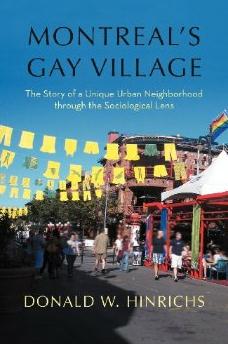While teaching a course in urban sociology at McGill University, Donald Hinrichs recalls, he repeatedly came back to a specific comparison. “I kept using Montreal’s Gay Village as an example of a distinct urban neighbourhood,” he says. “And I thought it was strange, because no one had written a book on the topic. I thought it would make for an interesting study.”
And it has. Hinrichs spent the last four years poring over documents and interviewing residents, historians, sociologists and gay activists about Montreal’s storied neighbourhood. The result is Montreal’s Gay Village: The Story of a Unique Urban Neighbourhood Through the Sociological Lens, a study that is exhaustive but accessible.
Hinrichs writes about when the neighbourhood first became identified as gay, why it moved from the downtown core further east during the ’70s, and what the future is for what many consider a gay ghetto.
“In terms of tone, I wanted a book that could be used by students and professors but would be accessible to the public as well,” Hinrichs says. “I felt like I found that happy medium.”
Hinrichs also analyzes literary references to the Village, in particular the work of Quebec’s literary godfather Michel Tremblay, who he also interviews for the book.
Tremblay discusses how the Village became established as the gay ’hood, recalling that journalists were uncomfortable when Tremblay held one of his book launches at a gay pub in 1980. Because of his stature as a writer, the journalists were forced to attend, giving further publicity to the Village and strengthening its reputation as a gay hub.
Tremblay also supplies one of the book’s best quotes: when asked if he thinks the Village is really just about gay men — and not really anyone else in the queer spectrum — he replies, “If it’s true, so what. I don’t think that gay people can invent a new society that is perfect.”
Hinrichs throws a wrench into the theory that Montreal’s gay centre moved east from downtown due to homophobic harassment by a then-hostile municipal government. “There are a variety of theories as to why the Village moved. But Bernard Rousseau, the owner of Priape, said his business moved for a simple reason: the rents got way too high to afford.”
Hinrichs also tackles the thorny issue of the future prospects for Montreal’s Village. Like all gay neighbourhoods, many have predicted its demise. In fact, Hinrichs cites a 2007 New York Times article on American urban gay and lesbian neighbourhoods, which asked if such places were, in fact, facing “the prospect of being passé.”
Hinrichs insists such neighbourhoods are still popular with young members of the gay community and says that at least some of their demise has more to do with rising rents and gentrification. He points out that San Francisco’s Castro district is still extremely popular with gays, but as living in a gay ’hood became less of a stigma and as real estate prices rose, more well-heeled straight people have moved in.
Hinrichs holds out hope that Montreal’s Gay Village has a long and diverse future.
“People talk about the internet and that people all meet online now. But I don’t know about that. You can’t dance online. When I go down to the Village here, it seems like the bars and clubs are full. The neighbourhood still feels like a very popular place, with locals and tourists.”
Montreal’s Gay Village
Donald Hinrichs
$18.95
iUniverse Books

 Why you can trust Xtra
Why you can trust Xtra


